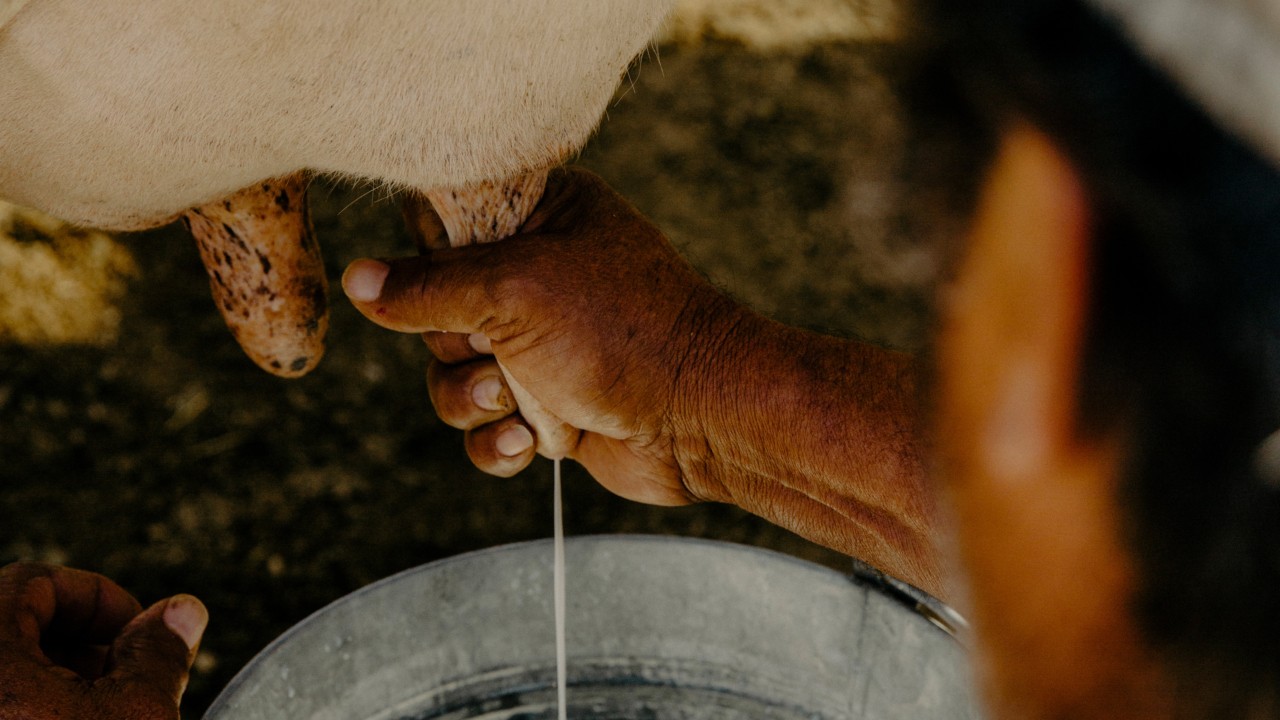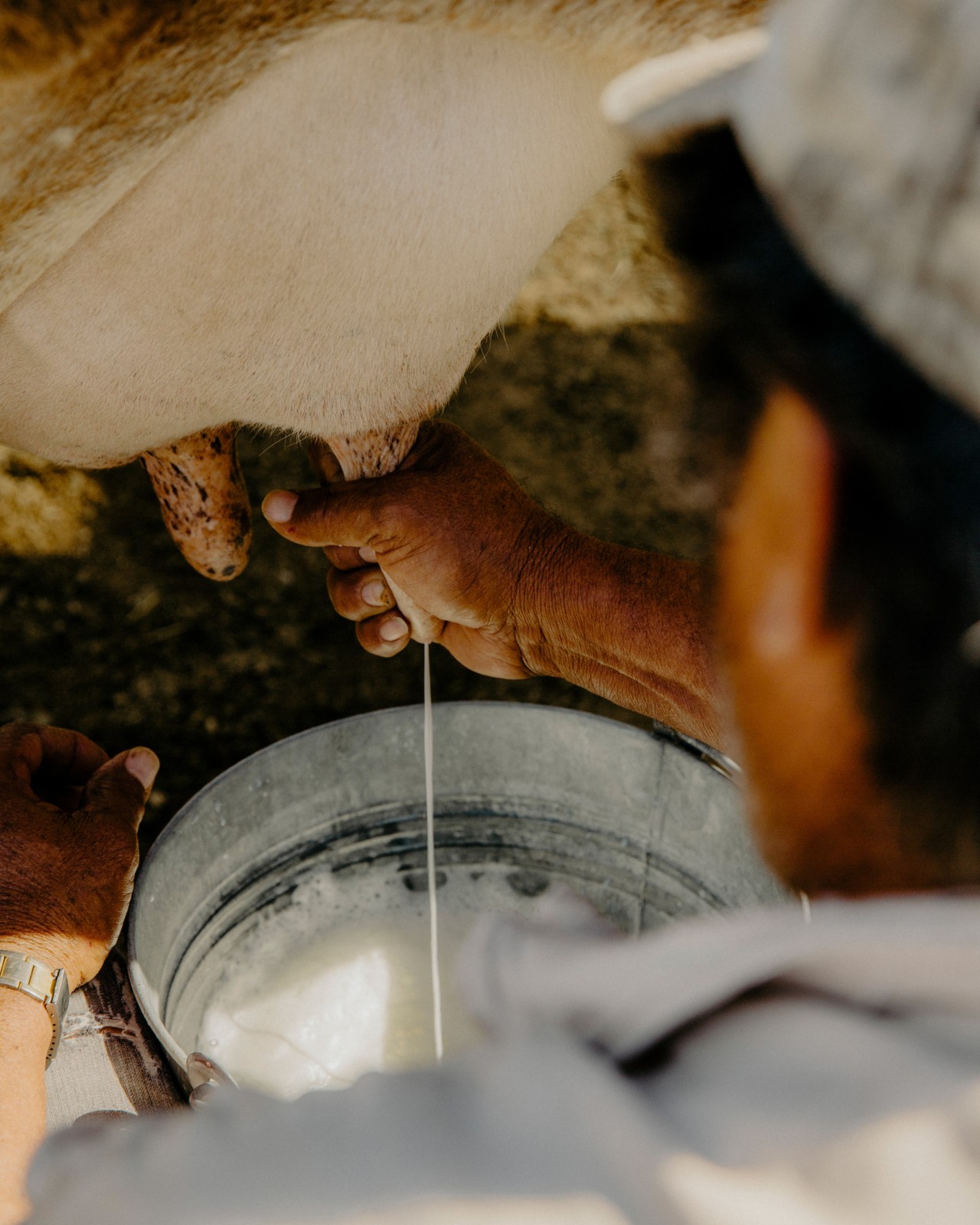

Photograph by Grant Harder / Kintzing
WORDS BY CLAIRE GREENBURGER
Jose Luis Cordova starts work every day by 4 a.m. It’s still dark as he begins ushering cattle to and from the milking parlor. Cordova lives on-site at the farm in Enosburg, Vermont, where all day he can hear the rumble of tractor engines, the clip-clop of hundreds of hooves, and a near-constant lowing. Born in Mexico, Cordova has been working on dairy farms like this one since he crossed the border without documentation nine years ago.
While working on the farm in 2018, Cordova began to feel a toothache. He went to a dentist in the nearby town of Richford. While driving home, a Border Patrol car trailed him. He was pulled over, handcuffed, and detained.
Approximately 1.5 million immigrants were deported nationwide during President Trump’s first term—a number surpassed by President Biden between 2021 and 2024. With Trump pledging “the largest deportation program in American history” in his second term, farmworkers are bracing for even more aggressive crackdowns across the U.S..
“Fear has really increased in the immigrant community, especially amongst farmworkers,” Luis Jiménez, an undocumented farmworker in western New York and founding member of Alianza Agrícola, told me in Spanish. Advocates warn that mass deportations could uproot millions, disrupt the American food supply chain, and weaken labor protections for farmworkers. But in Vermont and other rural areas across the U.S., farmworkers and their allies are mobilizing to defend immigrants’ rights.
The Vermont dairy industry underwent a vast transformation in the last few decades as small family farms consolidated into larger, factory-style operations that rely on cheap, hired labor. In 1969, state records show there were 4,017 registered dairy farms in Vermont; today, fewer than 600 remain. Still, dairy production has increased: The state now produces two-thirds of all of the milk in New England—and so too has the demand for dairy workers.
The farms that have managed to stay afloat have done so “by hiring workers from outside of the country,” said Teresa Mares, director of the graduate program in food systems at the University of Vermont. Today, an estimated 1,500 undocumented workers are employed on Vermont’s dairy farms. Nationally, they are part of the roughly 1 million undocumented farmworkers who power the agricultural economy while facing the constant threat of deportation.
American farmworkers endure physically demanding, hazardous, and low-paying jobs. Many lack standard labor protections, such as overtime pay and the ability to unionize. Any farmer will tell you that the industry relies upon this workforce and being able to “pay them as little as possible,” said Elizabeth Walle, director of fundraising and communications at the Food Chain Workers Alliance.
For decades, Vermont’s dairy workers have “existed in the shadows,” Cordova said in Spanish. They would rarely leave the farms. “You had to ask a friend to go buy you food,” he said. As one of the whitest and most rural states in the country—and a border state with an increased presence of immigration enforcement—migrant farmworkers in Vermont face heightened risks of racial profiling. However, under the leadership of Migrant Justice, a grassroots and farmworker-led organization formed in 2009, dairy workers in the state have gradually gained more freedom and independence. “I got involved with Migrant Justice to be part of that change,” Cordova said.
“Fear has really increased in the immigrant community, especially amongst farmworkers.”
After his arrest, Migrant Justice helped Cordova obtain an immigration bond, which allowed his release from detention while his case was being processed. During that time, the Biden Administration implemented new guidelines stipulating that an immigrant’s history of advocating for labor rights should be a mitigating factor in enforcement decisions. On those grounds, Cordova’s deportation case was closed, and he was allowed to stay in Vermont. Those protections and others, however, could “be erased” under Trump, warned Will Lambek, an organizer with Migrant Justice.
During Trump’s first term, Migrant Justice regularly received calls from immigrants who were arrested for what Lambek calls “driving while brown.” Immigration officers stopped Latino drivers, questioned vehicle occupants, and detained those found undocumented, according to Lambek. In some cases, Border Patrol agents acted on citizen tips about people speaking Spanish in public spaces. In Vermont, enforcement did not extend to private property for worksite raids, but Lambek fears this could change.
Trump declared a national border emergency on inauguration day this year. During his first full day in office, he rescinded a Biden-era memo that restricted immigration raids at schools, hospitals, and churches. On Thursday, U.S. Immigration and Customs Enforcement raided a workplace in Newark, New Jersey—a sanctuary city. ICE arrested 538 people across the country that day.
Although experts question the logistical—and legal—feasibility of deporting the estimated 11 million undocumented immigrants living in the U.S., they believe there’s cause for concern. “I think we should take [the threats] seriously,” said Mares, who emphasized the potential for widespread suffering, human rights violations, and family separations.
Mass deportations would also gut the agricultural workforce, 40% of which is comprised of undocumented workers. One likely avenue the administration would take to fill that void is to expand H-2A, the temporary visa program that allows U.S. employers to hire foreign workers for seasonal farm jobs, Walle said. But members of the Food Chain Workers Alliance, which includes Migrant Justice, oppose those efforts.
“[H-2A] benefits the agricultural industry at the expense of workers,” Lambek said. A 2013 report from the Southern Poverty Law Center, titled “Close to Slavery,” documented widespread abuses faced by H-2A workers, including wage theft, squalid living conditions, denial of medical benefits, and vulnerability to human trafficking. They often live on the farms where they work, isolated from the community, “so they don’t really have resources if they have a problem on their farm,” Walle explained.
Lambek said that such programs pursue the same outcomes as immigration enforcement: maintaining an exploitable workforce. “The more precarious people are and the more scared they are,” he said, “the fewer protections for their rights they have, and the more capable they are of being abused and exploited.”
Although dairy workers are excluded from H-2A because milk production is year-round, not seasonal, there has been a recent push to change that. If it succeeds, current workers would “almost certainly” be displaced, Lambek said, as these programs would likely be accompanied by mandatory work-authorization verifications, audits, and worksite raids.
Advocates caution that those measures could force many farms to significantly curtail or cease operations. A study published in September 2024 found that mass deportations would cut the agricultural workforce by 16%, and another from 2015 projected that losing the immigrant workforce would cause milk prices to spike by 90%. Mass deportations would, in essence, mean “a collapse in our agricultural economy,” Mares said.
“Our community is here, and we’re going to keep organizing, keep fighting for our rights, and keep working hard so that every day is better than the day before.”
In the months since Trump’s victory, Migrant Justice has been preparing to defend migrant workers from deportation. For example, the group has been bolstering its rapid response network, a coalition of volunteers who rally to support undocumented immigrants at detention sites. The presence of allies has been shown to improve the chances of a bond being issued to detainees, Lambek said.
These volunteers warn the community of detention risks. During Trump’s first term, Customs and Border Patrol set up sudden checkpoints on roads in the northern parts of the state. Volunteers in Grand Isle County responded by holding signs a mile away to alert drivers.
Migrant Justice also works to fortify laws that protect immigrants. Vermont’s Fair and Impartial Policing policy, for instance, limits police collaboration with immigration enforcement officials. Nationwide, 1 in 4 counties have policies in place that limit police collaboration. After years spent testifying, negotiating with decision-makers, and working with local jurisdictions, Migrant Justice successfully campaigned last spring to close loopholes in Vermont’s FIPP laws. Now, the organization’s focus is on ensuring law enforcement agencies properly abide and hold officers accountable.
Another major focus of Migrant Justice has been to educate community members about their rights, Cordova added. The organization hosts community assemblies where migrants learn how to navigate interactions with immigration enforcement. These sessions often involve role-playing scenarios: One person acts as a Border Patrol agent, while another plays a driver being questioned. One of the most critical things to know, Lambek said, is “the right to remain silent.”
Similar resistance efforts are emerging in rural areas across the country. In New York, the farmworker justice organization Rural and Migrant Ministry has been revamping its toolkit to help allies support immigrants and counter anti-immigrant rhetoric. Solidarity can be “as simple as having a sign in front of your congregation that welcomes immigrants,” said Richard Witt, executive director of RMM.
In Florida, organizers have been working with families of mixed documentation status to create “Family Preparedness Plans.” If one or both parents get deported, the family has a packet with their children’s medical information, passports, and a childcare plan, said Rene Gomez, civic participation coordinator at the Farmworker Association of Florida. Efforts to protect undocumented communities have been met with more resistance in red states. FWAF has been trying to work with local schools to create a plan for students whose parents are at risk of deportation, but “unfortunately, there’s been a lot of hesitation and tentativeness,” Gomez said.
In the face of uncertainty, these grassroots organizations are staying committed not only to defending against immediate threats but to laying the groundwork for long-term systemic change, which includes expanding protections for farmworkers.
“Our community is here, and we’re going to keep organizing, keep fighting for our rights, and keep working hard so that every day is better than the day before,” Cordova said.
For farmworkers like Cordova, the fight is about more than defending their right to remain: It’s about building an agricultural economy that values the humanity and contribution of its workers—one where fair treatment and justice are non-negotiable.
How Mass Deportations Could Gut the US Food System